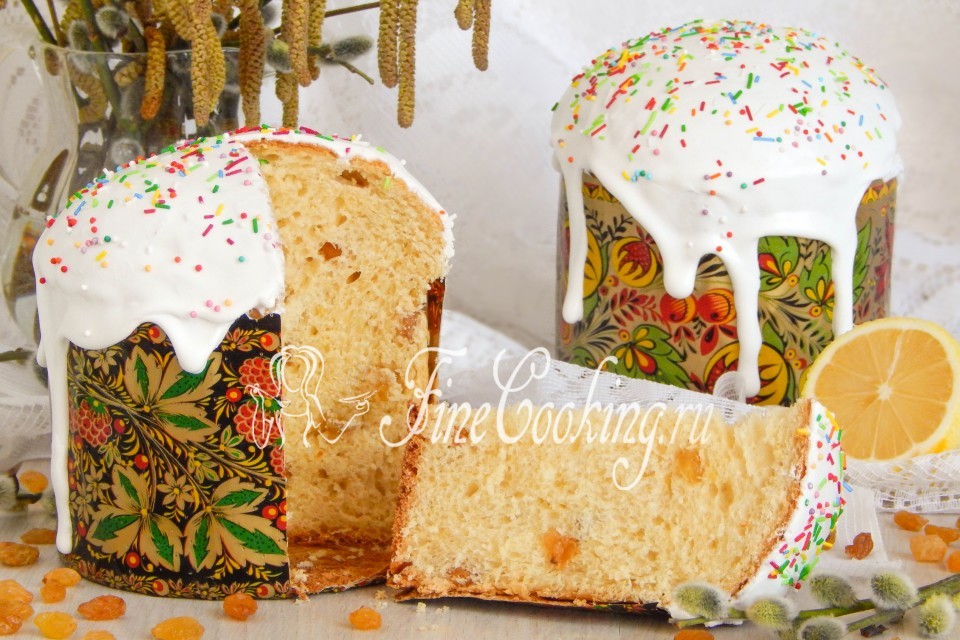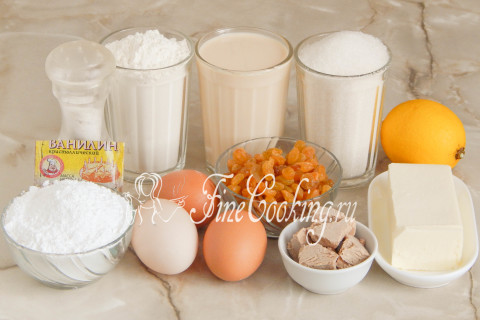Step 1
Here, all the products that enter the recipe for Alexandrian cakes: high -grade wheat flour, ghee, granulated sugar and granulated sugar, chicken eggs, butter, raisins, juice and lemon zest, fresh yeast, salt and vanillin (you can replace a teaspoon of vanilla sugar). Melon milk can be easily cooked independently — on the stove or in a slow cooker (here is the recipe). I used an average size (about 55 grams each), and 1 protein left for glaze, and 2 proteins and 3 yolks went to the dough. Choose any raisins — I have gold, it is sweet and very tasty. Yeast is not necessary to use fresh (pressed) — dry are perfect (about 12 grams or 2 teaspoons with a hill).
Step 2
In the evening, we will prepare dough (if this mass can be called that). In a rather large bowl, we connect 3 egg yolks, 2 proteins and 230 grams of granulated sugar. Mix everything thoroughly with a spoon or with the help of a mixer (corolla) — let the sugar crystals dissolve.
Step 3
Next, add 125 grams of soft butter, which or cut into small pieces or simply break the spoon. We intervene it in the egg mass.
Step 4
We pour 250 milliliters of ghee into another dish and crumble 35 grams of pressed yeast there.
Step 5
Mix everything until the yeast is completely dissolved — fresh ones diverge very quickly in milk.
Step 6
Now we pour yeast ghee into an egg-oil mixture.
Step 7
Mix everything thoroughly (you can use a mixer), cover with cling film and leave at room temperature for 8-12 hours.
Step 8
During this time, the downshole will rise and begin to sink, while on the surface it will be well distinguished by the oil layer, and there will be fermentation (many, many air bubbles) under it. I had a 2 -hour downshole.
Step 9
It's time to move on to the batch of dough for our Alexandrian Easter cakes. Choose a suitable container, pour the dug into it. Add 600 grams (it may take a little more or slightly less depending on the moisture of the flour) sifted wheat flour of the highest grade mixed with a pinch of vanillin and a quarter of a teaspoon of fine food salt. We immediately put there a 1 tablespoon of chopped lemon (you can orange, if you want) zest — this is about 1 large lemon.
Step 10
Mix all the components so that the sticky cake of the dough is obtained. It does not look like yeast for bread — the cakes dough are much more tender and sticks very much to the hands. Now it's time to add 100 grams of raisins, which must be pre -washed and dry. If the raisins are too dry, soak it in the water for 10-15 minutes, and then dry thoroughly.
Step 11
We knead the dough for about 10 minutes with your hands, which can be slightly lubricated with oil. We round the dough, tighten the bowl with cling film or cover with a towel and leave to wander in heat for 1.5 hours. Where is it better to wander the test and what does a warm place mean? There are several options. First of all, in the oven with a light bulb turned on (it turns out about 28-30 degrees — the temperature ideal for fermentation of yeast dough). Then we tighten the bowl with the dough with cling film or cover with a towel made of natural fabric (flax is best suited) so that the surface does not be swollen and not covered with a crust. You can also let the dough wander in a microwave, in which we pre -boil a glass of water. The dough will rise with a door closed, and the glass will stand there. Then the bowl does not need to be closed with anything, since the water will evaporate, thereby maintaining the necessary humidity. Just make sure that no one inadvertently turns on the microwave, otherwise the dough will disappear and there will be no Easter cakes.
Step 12
After about an hour and a half, the yeast dough will increase at least twice, and maybe more. Gently crumple it and lay it out in baking forms.
Step 13
I got 3 cakes dough. Each workpiece weighing 460 grams. I used paper forms (12 centimeters on the bottom and 10 centimeters in height). It is important to apply the dough no more than half the volume, so that in the process of baking, the Easter cakes do not run away. We cover the workpieces with cling film so that the dough does not be swollen and not covered with a crust. We send it to a grind in a warm place until the dough grows one and a half to two times. It took me 1.5 hours.
Step 14
The workpieces ready for baking should not go beyond the top of the form — ideally there should be a free space by 1.5-2 centimeters so that the test is where to grow further.
Step 15
In advance, we turn on the oven to heat up 180 degrees. We bake the Alexandrian cakes at the same temperature for the first 30 minutes at the average level of the oven, after which we reduce the temperature to 160 degrees and bake for another 20 minutes. We check the readiness with a wooden skewer or toothpick — it came out of the dry dough, then everything is ready. As a rule, I never lubricate the blanks before baking either an egg or milk — I do not like a strongly fried top. It is still then to decorate it with glaze.
Step 16
While the Easter cakes are cooling, we will make sugar icing. To do this, we simply connect 150 grams of sifted powdered sugar with one egg protein and rub everything thoroughly with a spoon, fork or spatula until the powder is completely dissolved. Recently, I am doing this with the help of a mixer — it is faster and easier, and the result is the same. Gradually add more powdered sugar. At the end, pour a little lemon juice and mix everything well again. The glaze should turn out to be homogeneous, smooth and brilliant. Sugar powder may need more or less depending on the size of the protein. If you want a thick icing, add more powder, but gradually.
Step 17
We cover the slightly cooled, but still warm cakes of sugar icing and, if desired, decorate with confectionery sprinkling or other decor of your choice.
Step 18
Without waiting until the Easter cakes finally cooled and ripen (it takes 5-8 hours), we immediately took off the test. You see, the cake is perfectly cut and does not crumble even in a warm state. Very aromatic, delicate, directly cream crumb, thin crust and sweet icing. A wonderful recipe and always a great result — I really advise you to try!


















